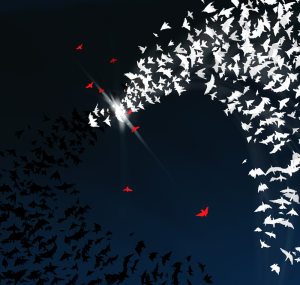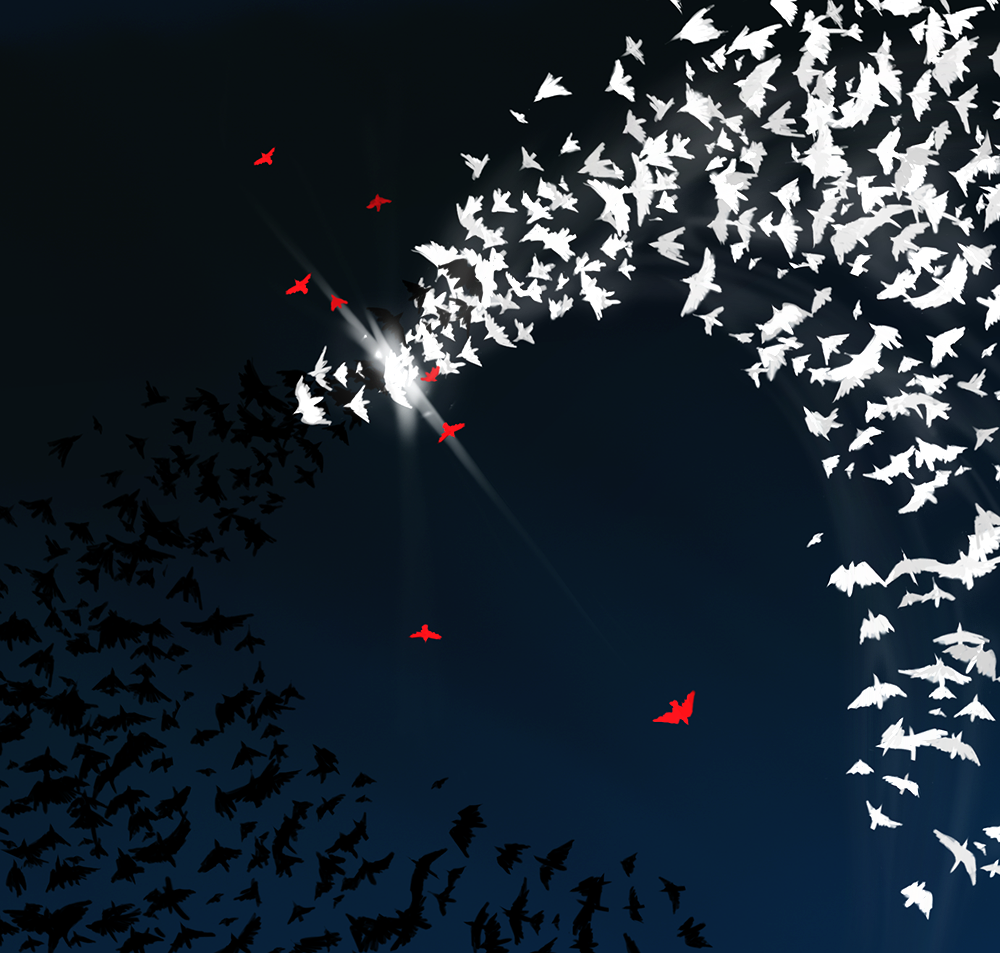An essay by Noscanaran’e’Prelapsis, as provided by Jaime Babb
Art by Leigh Legler
Excerpt from “A Survey History of the Human Worlds”, c. 70 500 A.I., compiled by Noscanaran of Taxekentak:
The planet 47 Ursa Majoris-3, locally known as Ecthalion, is home to a small population of Orange Three-Toed Humans, thought to be offshoots of the Human population of the nearby Pi-2 Ursa Majoris System. Although no known record of a colony survives, it is believed (due to linguistic similarities) that the original Human settlement was established by Chaos-worshipping religious pilgrims during π2 UMa’s 27th Imperial Dynasty, approximately two thousand standard years before present (Terrestrial frame). The planet was only inhabitable through the use of arcologies at the time of settlement, although terraforming during the intervening centuries has rendered the planetary surface habitable by most land-going Human subspecies. Nevertheless, the legacy of arcological modes of living has left an indelible mark upon the local culture and political institutions, in a manner similar to that seen on other worlds similarly settled. Ecthalion’s society tends to be highly structured and circularly-hierarchical, with a complex system of noblesse oblige constraining the behaviour of the Upper Classes, though it is reported that certain aristocrats, freed from the constraints of arcological living, have taken to shunning their sense of obligation. It is therefore expected that class strife will take place within the coming centuries.
The planet itself possesses an inactive core; the planetary magnetic field is rather generated by a network of artificial satellites, putatively put in place by the planet’s original settlers, though the details of its origin are shrouded in legend.
On the whole, Ecthalion is largely unremarkable, and would be similar to the point of interchangeability to any number of other planets inhabited by Human subspecies, were it not for a certain unconfirmed rumour: namely, it is popularly believed by the inhabitants of Ecthalion that their system is home to a cosmic string fragment, or other topological defect, and that this defect has subtly altered the laws of physics throughout the region. While no reputable scientific survey of the volume of space immediately surrounding 47 Ursa Majoris appears to have been undertaken–and the claim has therefore never been either confirmed or falsified–the legend appears to be well enough known on nearby worlds that Ecthalion is subject to a steady influx of private “treasure hunters.” For several centuries, these Hunters have constituted Ecthalion’s primary economic driver and revenue source–as such, the Ecthalion state has been largely configured around this industry, and external scholars should therefore be inclined to view indigenously-produced scientific surveys with skepticism, as it is likely that the government may be falsifying reports in order to keep the hunt going.

Scientists, clerics, and philosophers have debated the nature of these strange birds for centuries, but some insight may be provided by those rare occasions upon which the different species have been witnessed together at the same time and place.
In particular, several reports make a number of highly exotic claims about divergences in the local laws of physics (supposedly caused by the elusive topological defect) but fail to give adequate details concerning research methodology. Surveys by external research agencies are seldom made, as the local government tends to severely restrict their activities, but the few such studies available to the author seem to debunk most of the more sensational rumours. For example, gravitation in the system appears to obey the typical inverse-square power law, rather than the inverse 2.01 power law frequently claimed, and there does not appear to be a single independently corroborated case of the local laws of statistical mechanics deforming themselves in order to produce an individual’s Heart’s Desire out of thin air. Unsuccessful Hunters leaving the system appear to be inclined to believe that the legends are true, but in the author’s opinion, they are probably filtering observed coincidences through the lens of their own cognitive biases.
There does, however, appear to be at least one well-corroborated natural phenomenon in the 47 Ursa Majoris system which has so far defied attempt at explanation. This phenomenon is popularly referred to as “the Birds of Ecthalion,” and will be described below.
To read the rest of this story, check out the Mad Scientist Journal: Winter 2015 collection.
Noscanaran’e’Prelapsis (usually called Noscanaran of Taxekentak) was a notable Icthyohuman historian, archivist, and polymath of the 70th millennium AI. Even as a tadpole in the sub-glacial seas of GJ-1002-6-5 (known as Taxekentak), Noscanaran demonstrated tremendous curiosity and a keen intellect, and so became a scholar at Taxekentak’s prestigious Basin of Wisdom by the age of 15. There, he completed his seminal work, “A Survey History of the Human Inhabited Worlds,” the most extensive almanac of its day. Following a scandal, Noscanaran was forced into exile, where he perished while trying to study a gamma ray burst first hand.
Terminally indecisive, Jaime Babb could never decide whether she wanted to be a physicist, an historian, or a writer, so she simply became all three. She currently lives in Winnipeg, Canada, where she makes her living editing scientific manuscripts and tutoring mathematics. You can read her thoughts about writing, science, transgender issues, and whatever else occurs to her on her blog at voxcorvegis.wordpress.com. Jaime also volunteers as editor of the popular science blog, theamateurrealist.com.
Leigh’s professional title is “illustrator,” but that’s just a nice word for “monster-maker,” in this case. More information about them can be found at http://leighlegler.carbonmade.com/.
Follow us online: